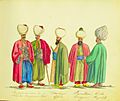Islam in Europe facts for kids
Islam is a major religion and the second-largest in Europe. It's also growing quickly. While many Muslim communities in Europe are quite new, some places, especially in the Balkans, have had Muslims for a very long time.
Islam first came to southern Europe between the 8th and 10th centuries. This happened when groups from North Africa, sometimes called "Moors," arrived. For centuries, there were Muslim kingdoms and areas in Spain, Portugal, Southern Italy, and Malta. However, after many battles and wars, these areas became Christian.
Islam also spread into the Caucasus region in the 7th century. Later, the Ottoman Empire, a powerful Muslim empire, expanded into southeastern Europe. They took over large parts of the Byzantine Empire in the 14th and 15th centuries. Over time, the Ottoman Empire became weaker and lost most of its lands in Europe. It finally ended in 1922. Today, countries in the Balkans still have many people who are native Muslims.
Where Muslims Live in Europe
The term "Muslim Europe" is sometimes used to describe countries where most people are Muslim. These include Albania, Kosovo, and Bosnia and Herzegovina. Other countries that cross continents, like Turkey, Azerbaijan, and Kazakhstan, also have many Muslims. Russia also has a large Muslim population, especially in its North Caucasus region.
In recent times, from the late 20th century into the 21st century, many Muslims have moved to Western Europe. By 2010, it was estimated that about 44 million Muslims lived in Europe, which was about 6% of the total population. In the European Union, about 19 million Muslims lived there, making up 3.8% of the population. Experts believe that by 2030, about 8% of Europe's population will be Muslim.
Discussions About Islam in Europe
The presence of Muslims in Europe often leads to many discussions and sometimes disagreements. These talks can be about different cultural practices or how people view each other. For example, there have been debates about Islamic clothing and how different cultures live together. Some political groups, often called populist right-wing parties, sometimes see Muslims as a challenge to traditional European culture.
These discussions have also led to more talk about Islamophobia. This word describes negative attitudes or unfair treatment towards Muslims. It's important to understand these different viewpoints and work towards respect and understanding.
Today, France has the largest number of Muslims in Western Europe. About 12.5% of its population is Muslim. In the European Union, Bulgaria likely has the largest percentage of Muslims, with about 15% of Bulgarians identifying as Muslim.
- Hourani, Albert (2002). A History of the Arab Peoples. Faber & Faber. ISBN 0-571-21591-2.
Images for kids
-
Arab-Norman art and buildings in Sicily mixed European styles with Arabic decorations and calligraphy.
-
Averroes was an important thinker who influenced new ways of thinking in Western Europe.
-
The Log pod Mangartom Mosque, the only mosque ever built in Slovenia. It was constructed during World War I.
-
The Ottoman army expanding into Europe in 1566.
-
Sofia, in medieval Bulgaria, was a key center for the Ottoman Empire in the Balkans.
-
A painting of the market in Athens, Ottoman Greece, from the early 19th century.
-
The Mosque of Twenty-Five Prophets in Ufa, Bashkortostan, Russia.
-
The Gazi Husrev-beg Mosque in Sarajevo, Bosnia and Herzegovina.
-
A map showing the percentage of Muslims in Europe in 2010, with projections for 2030, according to the Pew Research Center.
-
The Mosque of Rome, the largest mosque in the European Union.
See also
 In Spanish: Islam en Europa para niños
In Spanish: Islam en Europa para niños




















